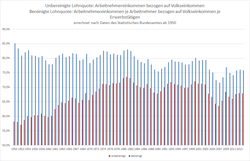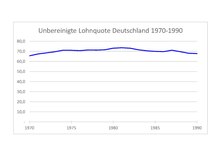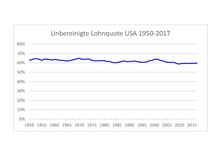Wage share
The wage share is
- an economic indicator for the share of employee compensation in national income ,
- a gross wage quota , in which the income is considered before taxes and social security contributions ,
- a net wage quota based on income after deduction of taxes and social security contributions,
- a measure of the functional distribution of income .
Its counterpart is the profit share .
calculation
In the following formulas, the wage share is given as a ratio. In all other explanations and graphics, however, the wage share is given as a percentage, i.e. it is multiplied by the factor 100.
Macroeconomic wage share
The macroeconomic wage share is obtained by dividing the wages of employees (wage income) by the total national income:
However, the macroeconomic wage share is only of limited informative value. It is influenced by changes in the employment structure, in particular by shifts in the ratio of dependent to self-employed workers , as the earned income of the latter is not included in the wage share. To prevent this problem, the adjusted wage share was developed.
Adjusted wage share
In the case of the adjusted wage share (bLQ), the macroeconomic wage share is adjusted for changes in the employment structure. For this purpose, the number of employed and dependent employees is standardized on a base year:
The reporting year (index t) is the year for which the wage share is to be calculated, the base year (index0) is a selected year whose employment structure is to be kept constant. The formulas show that in the base year the macroeconomic and the adjusted wage share are equal.
A disadvantage of this adjustment of the wage share is that the level depends on which base year is used. It is therefore only suitable for describing changes in the distribution between wage and profit income, not for describing the relationship for a current year.
Development of the wage share
- Germany
Compared to the 19th century, the gross wage share has risen significantly in Germany, as in the other industrialized countries. In 1870 the wage share in Germany was only 43.1 percent. It initially rose to 60.2% by 1930 and fell again to 54.9% by 1939.
In the post-war period, the unadjusted wage share rose from 65.6% in 1970 to its previous all-time high of 73.6% in 1981. It then fell to 67.8% by the time of German reunification in 1990.
Since reunification, both the unadjusted and the adjusted wage share have hardly changed: in 1991 they were 69.9% and in 2018 they were 69.0 and 69.2%, respectively.
- EU
In most of the other EU-15 member states , the wage share also peaked between 1974 and 1981. Since then, the quota has fallen significantly again in most EU countries, with one exception being Belgium, where the wage share was higher in the 2000s than in the 1960s. In addition to Germany, there is a longer trend towards a falling wage share. B. also in Greece, the Netherlands, Austria and Spain. The wage share is also falling in most of the new EU Member States. The smallest fluctuation in the wage share over the past 50 years has been in Denmark, and the largest has been in Greece, Ireland and Portugal.
- United States
In the US , the wage share fluctuated only slightly in the post-war period. It was 63% in 1950, has increased several times to 64% and was most recently 60% in 2017.
- International
In an international comparison, wage quotas are published, for example, in the Ameco database of the EU Commission.
Macroeconomic importance
The wage share is of great, but also controversial, importance in the political and, in particular, wage policy discussion. It is therefore one of the economic variables that the parties to the collective bargaining system take into account in collective wage negotiations.
Significance and problems of the wage share
The wage share provides certain indications for the distribution of income . However, a low wage share does not necessarily mean that there is a high unequal distribution of income, since wage earners can also earn other incomes, such as capital income. However, individuals with low wages seldom have capital income equal to or greater than high wages. In the US, the wealthiest 1% own 50% of the stocks, while the poorest 50% own only 0.5% of all stocks.
A high wage share also does not provide any information about the distribution of wage payments within the group of wage earners or about the respective number of people belonging to the group of wage earners. For example, one reason for the comparatively high wage share in Great Britain is that the bonuses achieved in the financial industry are added to wages. The distribution of wage increases has also been divergent for a long time in the USA.
The wage share only measures the wages of dependent employees. In contrast, the wages of the self-employed who have no employees are incorrectly added to the profit share. The profit income is shown too high and the labor income too low. This problem can be solved by using the more meaningful labor income quota , which is based on all labor income , instead of the wage share. However, this has the problem that the income from self-employment must be statistically divided into income from work ( entrepreneur's wages ) and the profit from self-employed or entrepreneurial activity.
The wage share as a measure of the functional distribution of income is also controversial because it assumes that households receive either wage or profit income, but not both at the same time. A meaningful distribution measure can only be obtained under this assumption. In industrialized countries, however, households are increasingly generating income from work and profit at the same time, which limits the informative value of the wage share. In addition, the wage share does not make any statements about the distribution of income within the wage income ( wage spread ). The personal income distribution is therefore considered to be more suitable for describing the distribution of income in industrialized countries .
The macroeconomic wage share is subject to a variety of influences. The most important include the union presence and wage policy, price developments and fluctuations caused by the economy.
literature
- Michael Grömling: Determinants of the wage share in international comparison. In: Social Progress. Vol. 53, issue 2 .; 2004
- Claus Schäfer: The wage share - an ambivalent indicator of social justice and economic efficiency. In: Social Progress. Vol. 53, 2004, issue 2.
- Thomas Weiß: The wage share after the turn of the millennium. In: Social Progress. Vol. 53, issue 2. 2004
- Deutsche Bundesbank: Seasonally adjusted economic figures for the month ..... In: Statistical supplement to the monthly report.
- Alexander Herzog-Stein, Jonas Löbbing, Ulrike Stein: Is everything different in the 2000s? The decreasing importance of sectoral structural change for the decline in the wage share in Germany. In: Social Progress. Vol. 65, issue 3. 2016
Web links
- Economic Outlook “Spillovers and Cycles in the Global Economy”, Chapter 5 The Globalization of Labor . (PDF; 893 kB) International Monetary Fund, April 2007 (English) With information on the development of the wage share.
Individual evidence
- ↑ Gabler Business Dictionary
- ↑ Heinz-J. Bontrup: wages and profits: economic and business basics. 2nd Edition. 2008, ISBN 3-486-58472-3 , pp. 53 ff., (Online)
- ↑ Federal Statistical Office, National Accounts, Long Series from 1970
- ↑ BMF monthly report, February 2019.
- ↑ European Commission: Employment in Europe 2007. pp. 240–243.
- ^ Federal Reserve Economic Data
- ^ A long and persistent middle-class squeeze. Economic Policy Institute , February 3, 2010.
- ^ Alfred Stobbe: Economical accounting. Edition 7th Springer Verlag, Heidelberg / Berlin / New York 1989, p. 332.







